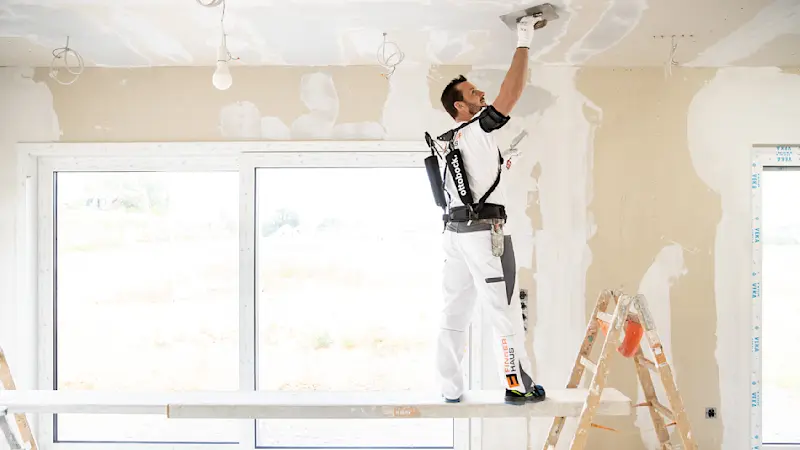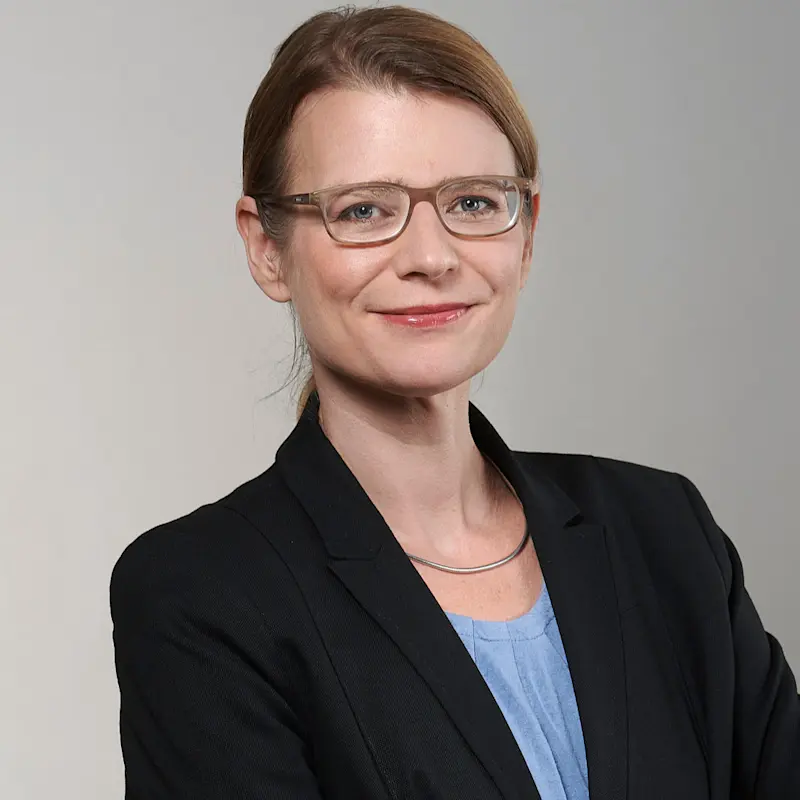
FingerHaus equips painters and decorators with Ottobock exoskeletons
The Paexo Shoulder takes the strain off during overhead work in the building trade
“I’m not giving this exoskeleton back!” – this was painter and decorator Paul Gradwol’s verdict after trying out the Paexo Shoulder at FingerHaus GmbH’s Health Awareness Day in July 2019. The company, which manufactures prefabricated wooden houses, has now equipped its three two-person painter and decorator crews with one exoskeleton each. The Ottobock system supports painters and decorators as they perform strenuous overhead tasks such as plastering or painting ceilings. “The exoskeleton really takes the strain off the muscles and joints in my shoulders. Now my arms don’t feel so heavy in the evenings,” says Gradwol. “I’m always open to trying out new approaches that make my work easier – and I’m hugely impressed with this system!”
Weighing in at 1.9 kg, the Paexo Shoulder is the lightest exoskeleton of its kind. The design is passive, so it doesn’t need an energy supply or battery. The arm shells transfer the weight of the arms to the hips using mechanical cable pull technology. It can be adapted easily to different user heights. The Paexo Shoulder is comfortable to wear, rather like a backpack, and doesn’t restrict the user’s freedom of movement in any way.
“Thanks to the exoskeleton, our painters and decorators find it more comfortable to not only perform overhead tasks but also to walk, sit or bend down to pick up objects,” says Andrea Schönhardt, who develops strategies for occupational health management as HR Officer at FingerHaus GmbH. “Our aim with the exoskeleton is to make building site workplaces healthier.”
Occupational health and safety in the building trade
“Exoskeletons can make a huge difference to occupational health and safety, particularly in the building trade. They reduce the physical strain involved in the frequent overhead tasks which are inherent to so many different trades – in drywall construction, for example, or when installing electrical, plumbing or heating systems. In such cases, it’s worth using an exoskeleton that has been designed specifically for the application in question,” says Dr Sönke Rössing, Head of Ottobock Industrials. “This type of preventive relief can reduce work-related musculoskeletal diseases in the shoulders.” These disorders are the most common cause for sick leave in Germany and Europe and are therefore a significant cost factor for companies and healthcare systems (source). Around 27 per cent of all absences in the building trade in 2017 were due to musculoskeletal complaints (source).
The industry also faces challenges such as a shortage of skilled workers and an aging workforce. As a result, there is a need for assistance systems that help people protect their health over the long term as they carry out their demanding everyday working routines. To address this need, Ottobock began in 2012 to develop the exoskeletons in the Paexo product range. The Paexo Shoulder has been on the market since October 2018 and costs around EUR 4,900 (leasing is available).
The portfolio of products for healthier workplaces also includes systems that reduce strain on the back, e.g., for people in the logistics industry who regularly handle heavy loads (Paexo Back and Paexo Soft Back). Ottobock has also developed products to help with tasks that place strain on the thumb or wrist (Paexo Thumb and Paexo Wrist).
Pictures and captions:
Photo 1:For the past year, Paul Gradwol, a painter and decorator at FingerHaus, has been using the Paexo Shoulder for strenuous overhead tasks. His verdict: “I’m not giving this exoskeleton back!” (Photo: fotografische Werkstatt, Katharina Jaeger)
Photo 2:The Paexo Shoulder exoskeleton transfers the weight of the user’s raised arms via the arm shells to the hips using mechanical cable pull technology. This provides noticeable relief to the shoulder muscles and joints and enables users to perform overhead activities much more comfortably. (Photo: fotografische Werkstatt, Katharina Jaeger)
Photo 3:The Paexo Shoulder by Ottobock is a passive exoskeleton that does not require an energy supply. This makes it especially lightweight – at 1.9 kilograms, it’s actually the lightest exoskeleton of its kind. (Photo: fotografische Werkstatt, Katharina Jaeger)
Photo 4:The Paexo Shoulder can be put on and removed in less than 20 seconds and can be comfortably worn for more than eight hours. The exoskeleton’s design is based on natural human movements. (Photo: fotografische Werkstatt, Katharina Jaeger)
Contact Person
Downloads
4 results out of 4

